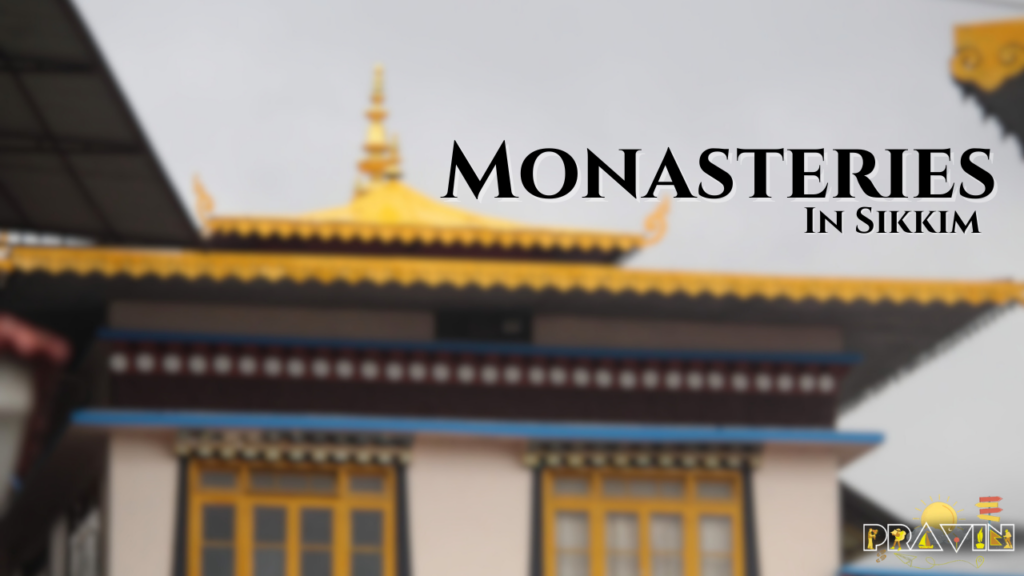Monasteries in Sikkim are places of worship that are guaranteed to keep a place in your heart even after your visit to the state of Sikkim ends. Well, people who have been to Sikkim, know that it is the land of many monasteries. If you ever want to experience peace and serenity, pay a visit to any of the monasteries in the state. Each city, each village, or district, has a monastery or so of its own. The Sikkimese cultures come out drooling through these monasteries.
Dubdi Monastery
Dubdi Monastery, situated on top of a hill in Yuksom, holds the distinction of being the oldest monastery in Sikkim. Dating back to the 17th century, this sacred site exudes an aura of calmness and spiritual significance, offering visitors a glimpse into Sikkim’s rich cultural heritage and Buddhist traditions.
Established in 1701 by Chogyal Namgyal, the first king of Sikkim, Dubdi Monastery belongs to the Nyingma sect of Tibetan Buddhism. The name ‘Dubdi’ translates to ‘the retreat’ in the local language, aptly reflecting the serene and isolated location of the monastery amidst lush green forests.
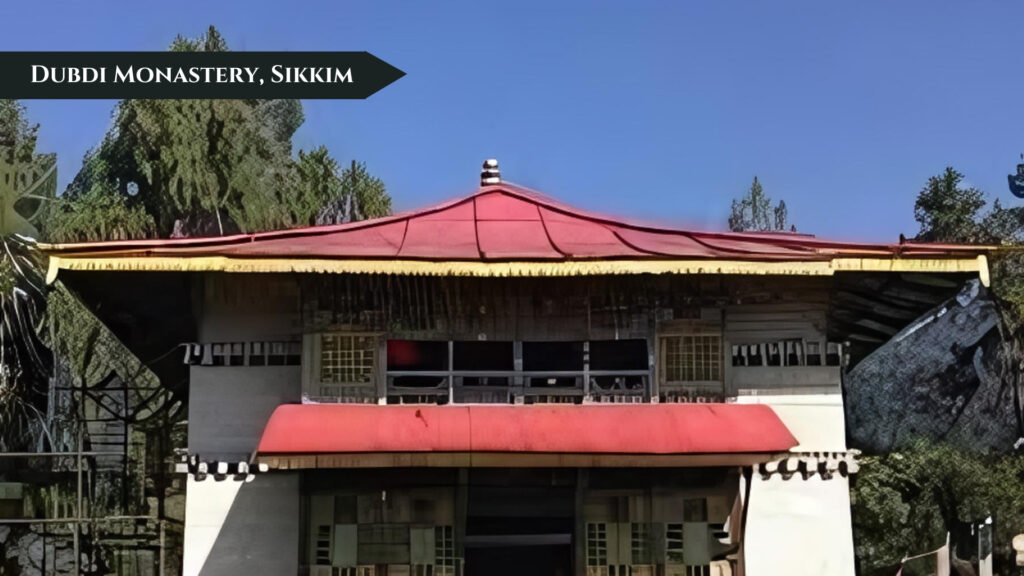
Why is Dubdi Monastery Famous?
Dubdi Monastery is renowned for several reasons:
- It is the oldest monastery in Sikkim, established in 1701, giving it unparalleled historical significance.
- The monastery is a key part of the Buddhist religious pilgrimage circuit in Sikkim, which also includes Norbugang Chorten, Pemayangtse Monastery, Rabdentse ruins, Sanga Choeling Monastery, Khecheopalri Lake and Tashiding Monastery.
- Its unique architecture featuring a two-storied stone structure with elaborately painted interiors housing rare manuscripts, texts, and images of divinities and saints attracts visitors.
- The remote and peaceful location on a hilltop surrounded by lush forests offers a spiritual retreat and attracts those seeking solace and peace.
- It provides a magnificent bird’s eye view of the surroundings and allows visitors to witness the rare Cupressus funebris trees brought from Tibet.
Thus, Dubdi Monastery stands as an architectural gem and a testament to Sikkim’s rich cultural, historical and religious heritage, making it a must-visit destination in the state.
Enchey Monastery
Enchey Monastery is a 200-year-old Buddhist monastery located in Gangtok, Sikkim. It belongs to the Nyingma order of Vajrayana Buddhism. The name “Enchey Monastery” literally means “the solitary temple”. Situated just a short walk from the heart of Gangtok, Enchey Monastery is a cherished religious site known for its peaceful ambiance and stunning architecture.

Why is Enchey Monastery Famous?
Enchey Monastery is one of the most popular pilgrimage sites and tourist attractions in Gangtok for several reasons:
- It is home to around 90 monks of the Nyingma sect and houses many sacred Buddhist artifacts, murals, scriptures and images of deities like Buddha, Loketeswara and Guru Padmasambhava.
- The monastery is renowned for its annual Cham dance festival held on the 18th and 19th day of the 12th lunar month of the Tibetan calendar (usually Jan/Feb). Monks perform elaborate masked dances depicting Buddhist deities and mythical creatures.
- Its unique Chinese pagoda-style architecture is an artistic adaptation of the sacred Gyanak Riwo Tse-Nga mountain in China. The monastery building is topped by a golden cupola.
- Enchey Monastery offers a peaceful, spiritual atmosphere with colorful prayer flags fluttering in its serene hilltop location surrounded by natural beauty. This makes it a major attraction for pilgrims and tourists alike looking to experience Sikkim’s Buddhist culture.
Kartok Monastery
Kartok Monastery is one of the most picturesque and historically significant monasteries located in the beautiful village of Yuksom in Sikkim, India. This vibrant red monastery with golden and yellow outlines is a prime example of traditional Tibetan architecture and design. Kartok Monastery, situated in rich greenery and snow-capped peaks, is celebrated for its insta-worthy setting and spiritual significance.
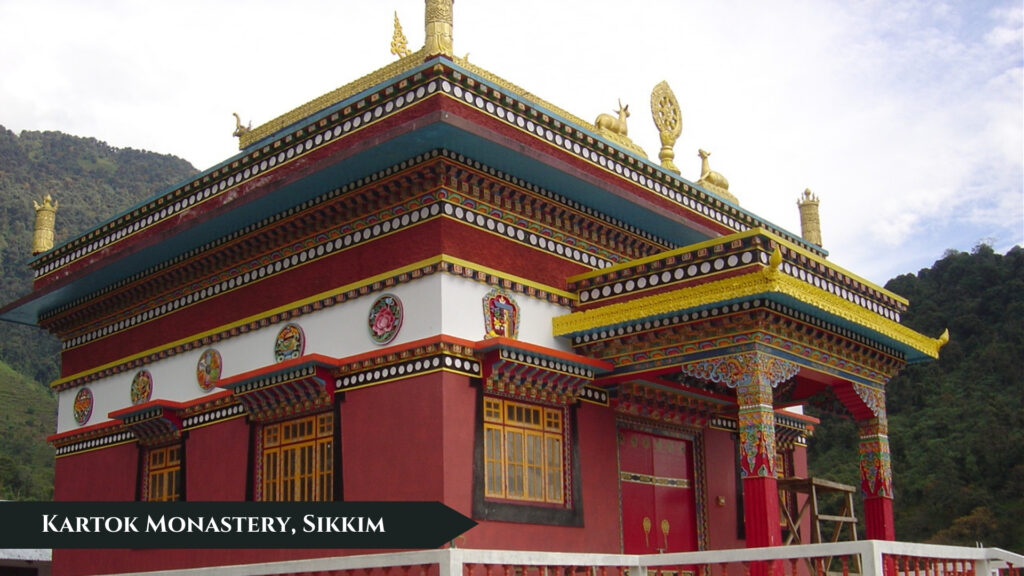
Why is Kartok Monastery Famous?
Kartok Monastery is renowned for its breathtaking beauty, unique architecture, and spiritual significance. The monastery’s impeccable interiors and grand entrance leave a lasting impression on visitors. It is an ideal location for photography, with its vibrant colors and remarkable backdrop. The monastery also holds its fossil charm, and the nearby Kartok Lake adds to its allure. Visitors can explore the shrine, take in the stunning views of the surrounding landscape, and immerse themselves in the tranquil atmosphere of this sacred site.
Lingdum Monastery
Lingdum Monastery, also known as Ranka Monastery and Pal Zurmang Kagyud Monastery, is a Buddhist monastery located near Ranka, about 20 km (an hour’s drive) from Gangtok, the capital of Sikkim, India. It was inaugurated in 1999 and follows the Zurmang Kagyud lineage of Tibetan Buddhism under the guidance of the 12th successor Zurmang Gharwang Rinpoche. View my Instagram Profile to see the real-time updates on the experiences that I gather. Happy travels!
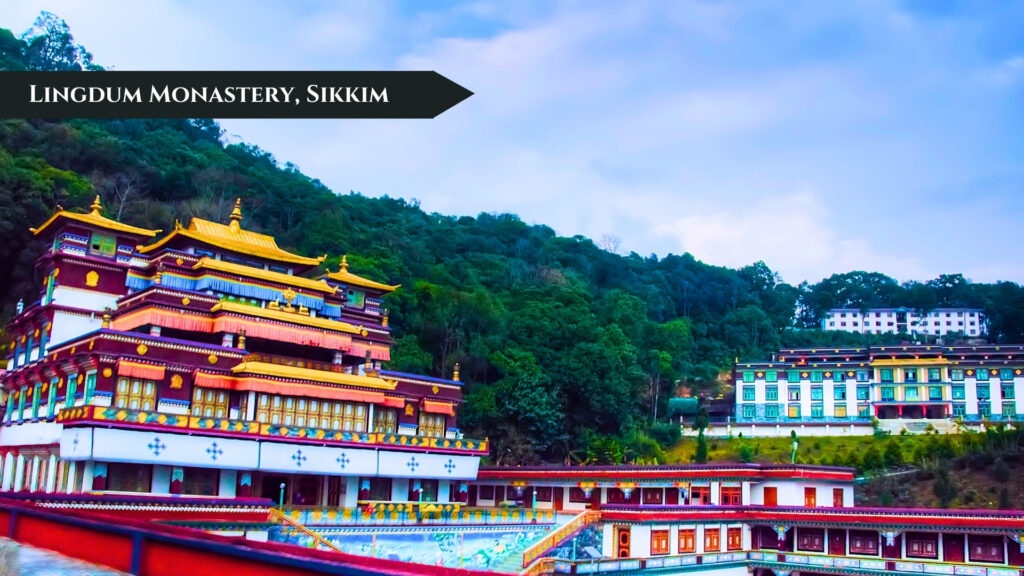
Why is Lingdum Monastery Famous?
- Lingdum Monastery is renowned for its serene atmosphere, aesthetic beauty, and the opportunity it provides for peace-seekers to immerse themselves in Buddhist culture.
- The monastery is particularly famous for the vibrant mask dances performed by the monks during festivals like Losar (Tibetan New Year) and Gutor. These dances, adorned with colorful symbolic frescoes, reflect the traditions and doctrines of Buddhism.
- Additionally, the monastery’s remote location and the nearby Banjhakri Falls contribute to its popularity among tourists seeking a tranquil and visually appealing destination.
Pemayangtse Monastery
Pemayangtse Monastery, perched on top of a hilltop in western Sikkim, has stood the test of time as a testament to the enduring legacy of Buddhism in the region. With its intricate woodwork, ancient murals, and peaceful atmosphere, this monastery provides a glimpse into Sikkim’s rich cultural heritage and spiritual traditions.

Why is Pemayangtse Monastery Famous?
Pemayangtse Monastery is renowned for:
- Being one of the oldest, largest and most important monasteries in Sikkim with a history dating back to the 17th century
- Its beautiful architecture with intricate paintings, sculptures and carvings depicting Buddhist teachings and deities
- Housing many ancient religious artifacts, scriptures and images considered sacred by Buddhists
- The stunning wooden sculpture of Guru Padmasambhava’s Heavenly Palace, Sanghthokpalri that took 5 years to carve
- Hosting the annual Cham dance festival where monks perform ritual dances in colorful costumes
- Offering breathtaking views of Mount Khangchendzonga and the Himalayan ranges
- Serving as the head monastery for all Nyingma sect monasteries in Sikkim
- Its historical role in anointing the kings of Sikkim and close association with the royal family
- Being an important pilgrimage site and tourist attraction showcasing Sikkimese Buddhist culture.
Phodong Monastery
Phodong Monastery, also known as Phodang or Podong, is a Buddhist monastery located in Sikkim, India. It was built in the early 18th century by Chogyal Gyurmed Namgyal, the fourth king of Sikkim. The monastery belongs to the Karma Kagyu sect of Tibetan Buddhism and is one of the six most important Buddhist monasteries in Sikkim.

Why is Phodong Monastery Famous?
- It houses a collection of ancient murals, paintings, and frescoes that adorn the walls of the monastery, showcasing exquisite artistic craftsmanship.
- The monastery is home to approximately 260 monks who reside and practice Buddhism within its premises.
- Every year, the monastery hosts a festival on the 28th and 29th days of the 10th month of the Tibetan calendar. During this festival, monks perform the traditional Chaam dance along with spiritual rituals.
- French explorer Alexandra David Neel spent a few years at Phodong Monastery, starting from 1912, learning Buddhism under the guidance of the third Lachen Gomchen. Some of her photos are displayed on the first floor of the monastery.
- Phodong Monastery is rated as one of the most beautiful and mesmerizing monasteries in Sikkim, attracting visitors and pilgrims from around the world.
Ralang Monastery
Ralang Monastery is a Buddhist monastery belonging to the Kagyu sect of Tibetan Buddhism. It is considered one of the most sacred monasteries in Sikkim. The old Ralang Monastery was built in 1768 AD by the 4th Chogyal of Sikkim to commemorate his successful pilgrimage to Tibet. In 1995, a new monastery called Palchen Choeling Monastic Institute was constructed by the 12th Gyaltsab Rinpoche, while still retaining the authentic Tibetan architecture.
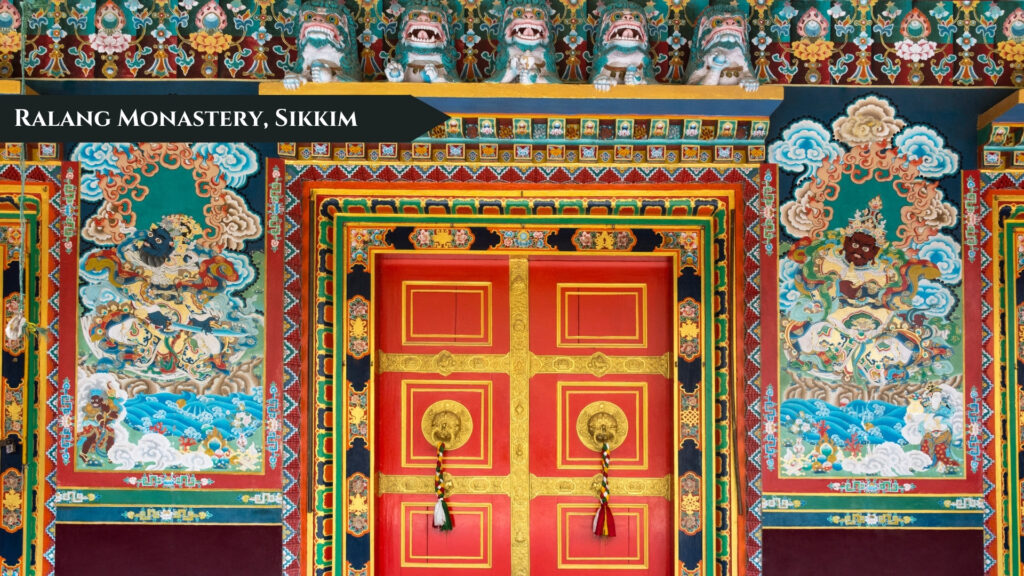
Why is Ralang Monastery Famous?
- It is one of the oldest and most sacred monasteries in Sikkim, with a rich history dating back to 1768 AD.
- The monastery is known for its unique Tibetan architecture and extensive collection of paintings and thangkas.
- It hosts the annual Pang Lhabsol festival, which attracts many visitors who come to witness the worship of Mount Kanchenjunga.
- The monastery is also famous for its Mahakala Dance, which takes place every year in November.
- The nearby Ralang Cha-Chu and Borong Cha-Chu hot springs are known for their medicinal and therapeutic properties, drawing visitors to the area.
Rumtek Monastery
Rumtek Monastery, perched on a hilltop overlooking the Gangtok cityscape, is renowned for its panoramic views and spiritual significance. Rumtek Monastery, also known as the Dharma Chakra Centre, is one of the most significant and largest monasteries in Sikkim, India. Founded in the 16th century by the 9th Karmapa Lama, Wangchuk Dorje, it serves as the seat-in-exile of the Gyalwang Karmapa and is a major center for the Karma Kagyu lineage of Tibetan Buddhism.
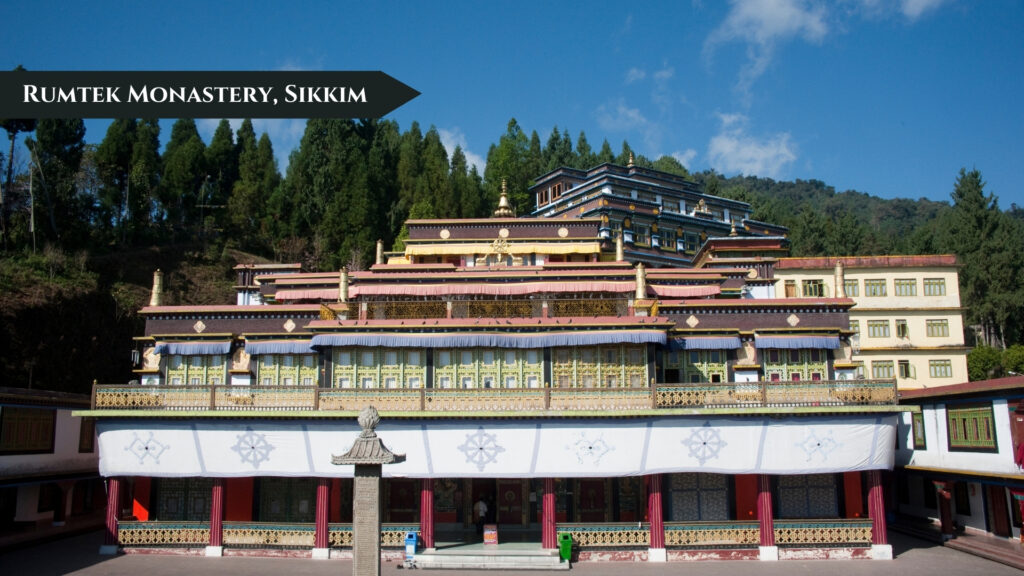
Why is Rumtek Famous?
- Rumtek Monastery is the largest monastery in Sikkim and serves as the seat-in-exile of the Gyalwang Karmapa, the head of the Karma Kagyu lineage of Tibetan Buddhism.
- The monastery is renowned for its intricate architecture and vibrant, colorful design, showcasing the best of traditional Tibetan monastic architecture.
- It houses some of the world’s rarest Buddhist art objects, sacred relics, and ancient manuscripts, making it a treasure trove of spiritual and cultural heritage.
- Rumtek is a major center for the study and practice of the Karma Kagyu teachings, attracting monks, scholars, and devotees from around the world.
- Rumtek hosts several important traditional festivals and events, such as Losar and Dungdrub Puja, which showcase Sikkim’s rich cultural heritage and attract visitors from far and wide.
Tashiding Monastery
Tashiding Monastery, situated in the scenic beauty of the Rathong-Chu valley, is reputed as one of the holiest monasteries in Sikkim. Tashiding Monastery is one of the holiest and most sacred Buddhist monasteries in Sikkim, India. It belongs to the Nyingma sect of Tibetan Buddhism and is considered the “heart of Sikkim” due to its immense religious significance.

Why is Tashiding Monastery Famous?
- Housing the most sacred stupa in Sikkim, the Thong-Wa-Rang-Dol, which is believed to grant liberation upon sight
- Being founded at a spot blessed by Guru Padmasambhava, making it an important pilgrimage site
- Its annual Bumchu festival, where sacred holy water from a precious vase is distributed to devotees for spiritual merit
- Containing relics of the Chogyals (kings) and Lamas of Sikkim
- Its picturesque location atop a hill surrounded by rivers and mountains
- Being the site of many miracles and divine occurrences as per local legends
- Serving as the head monastery for other monasteries of the Nyingma lineage in Sikkim
Tingvong Monastery
Tingvong Monastery, tucked away in the hills of Sikkim, is like a serene sanctuary for anyone seeking peace and spiritual solace. Tingvong Monastery is a beautiful and historically significant monastery located in the village of Tingvong in the Dzongu region of North Sikkim. It was built in 1843 by Lama Tambi and is an important religious site for the local Lepcha community.
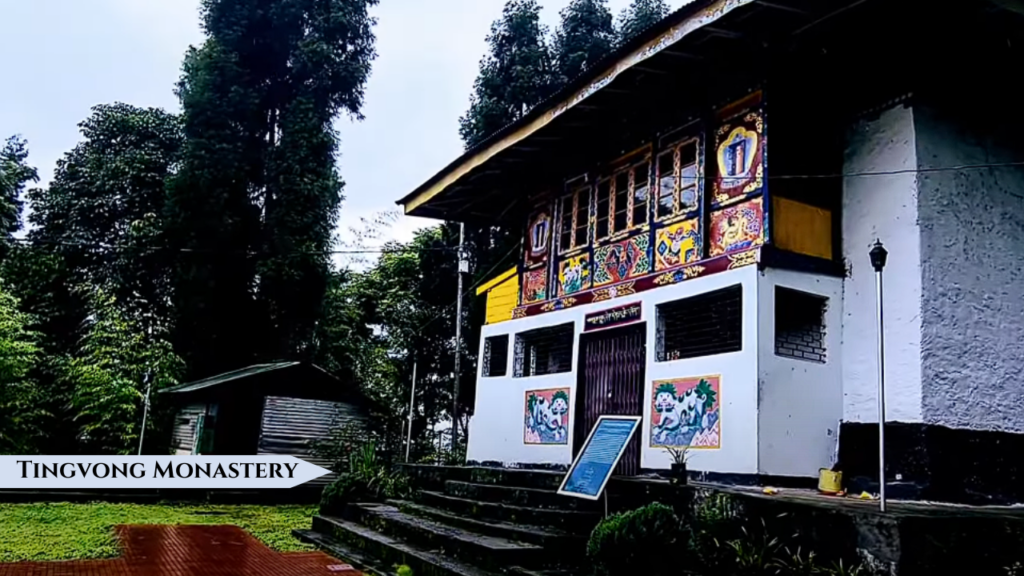
Why is Tingvong Famous?
- It is home to the historic Tingvong Monastery, an important religious site for the Lepcha community
- The village offers stunning views of the Kanchenjunga mountain range and surrounding valleys
- It provides a unique opportunity to experience the traditional Lepcha way of life and culture
- The village is a starting point for several scenic treks, including the Tholung Monastery trek
Gonjang Monastery
Gonjang Monastery, located in Sikkim, is a serene spot for spiritual seekers. Gonjang Monastery, also known as Gonjang Gompa, is a Buddhist monastery located in Gangtok, Sikkim, India. It belongs to the Nyingma order of Tibetan Buddhism and was founded in 1981 by H.E. Tingkye Gonjang Rinpoche. The monastery has been blessed by the Dalai Lama himself and serves as an important center for Tibetan cultural heritage and Buddhist learning in the region.
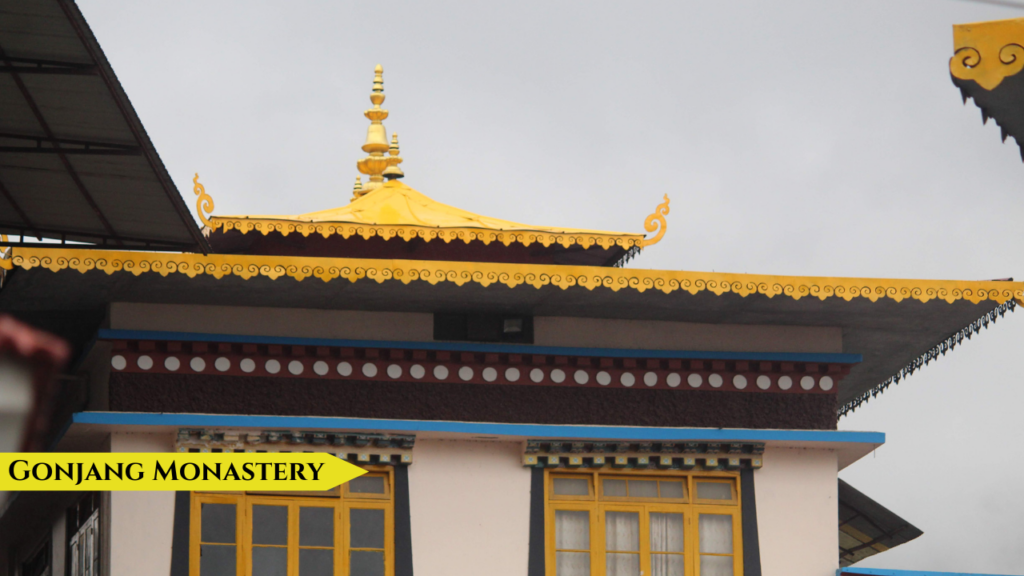
Why is Gonjang Monastery Famous?
- It houses unique religious artifacts, including idols of Khen-lop Cho-Sum, the three founding fathers of Tibetan Buddhism from the 8th century, and engraved statues of the twenty-five prominent disciples of Guru Padmasambhava, collectively known as Je-bang Nyer-Nga.
- The monastery features intricate murals and vibrant architectural elements, creating a peaceful and visually appealing atmosphere for visitors.
- It offers a serene ambiance and a spiritual retreat from the hustle and bustle of city life, attracting tourists seeking tranquility and a connection with Buddhism.
- The monastery provides a Thadrol Dorjee Memorial Community Health Care Centre, which offers medication to monks and local people, showcasing its commitment to the well-being of the community.
- Its location offers stunning views of the surrounding landscape, making it a popular spot for photography and enjoying the natural beauty of Sikkim.
Chawayng Ani Monastery
Chawayng Ani Monastery, found in Sikkim, is a peaceful haven for those looking for a spiritual retreat. Situated amidst the serene hills, it offers a tranquil atmosphere perfect for meditation and contemplation. Chawayng Ani Monastery is a Buddhist monastery located in the northeastern Indian state of Sikkim. It belongs to the Tibetan Buddhist tradition and was founded during the reign of Chogyal Tsugphud Namgyal, who ruled Sikkim in the 18th century.
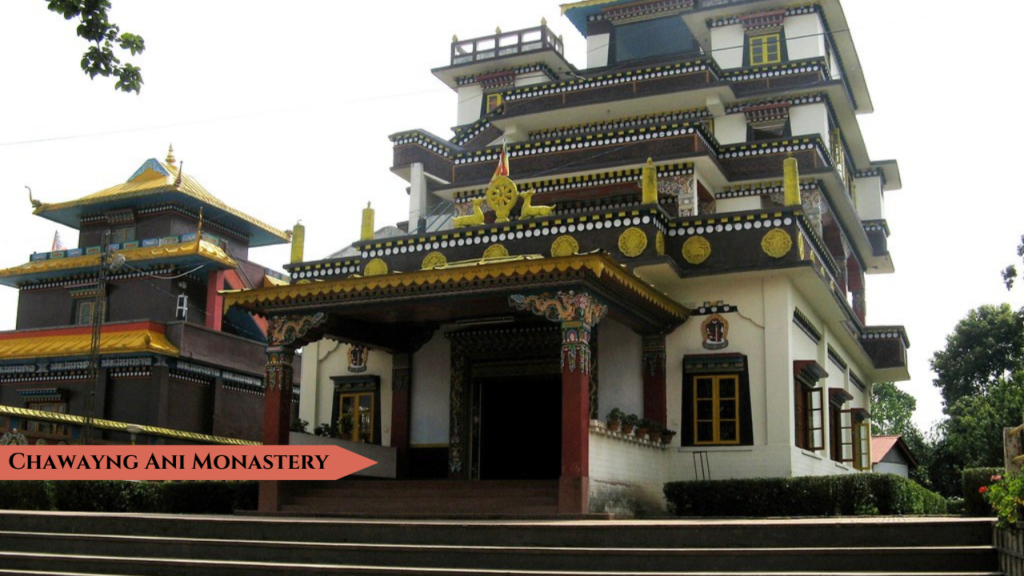
Why is Chawayng Ani Monastery Famous?
- It is one of the notable Buddhist monasteries in Sikkim, representing the region’s strong ties to Tibetan Buddhism.
- The monastery is known for its distinctive architectural style, which showcases traditional Tibetan Buddhist design elements.
- Chawayng Ani Monastery is a popular destination for visitors and pilgrims who come to experience its peaceful atmosphere and participate in religious ceremonies.
- The monastery’s location along the highway between Gangtok and Mangan makes it easily accessible and a popular stop for tourists exploring Sikkim’s cultural and religious sites.
- As a center for spiritual practice and learning, Chawayng Ani Monastery plays a significant role in preserving and promoting Tibetan Buddhist traditions in the region.
Do Drul Chorten Monastery
The Do Drul Chorten is a magnificent Buddhist stupa and monastery complex located in Gangtok, the capital city of Sikkim, India. Built in 1945 by Trulshik Rinpoche, the head of the Nyingma order of Tibetan Buddhism, this white stupa with its golden spire is one of the largest and most sacred in Sikkim. The complex includes the main stupa, several smaller stupas, two shrines with large statues of Guru Padmasambhava, and a monastery that can accommodate about 700 monks.
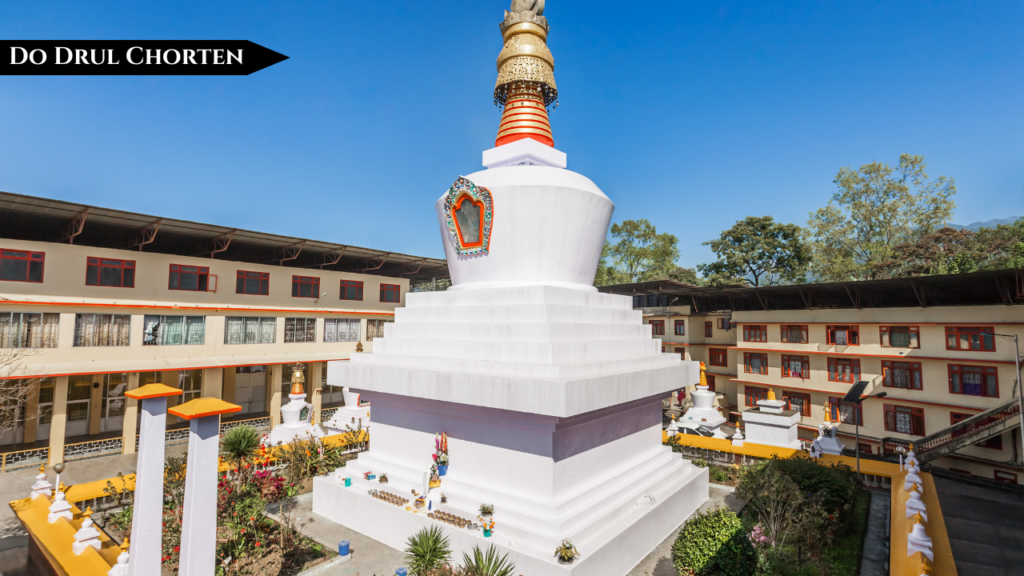
Why is the Do Drul Chorten Monastery Famous?
- It is one of the biggest and most important stupas in Sikkim, highly sacred to Buddhists
- The stupa was built by the renowned Trulshik Rinpoche and contains precious relics and religious texts
- It enshrines the powerful deity Dorjee Phurpa (Vajrakilaya) and is believed to ward off evil spirits
- The complex has 108 prayer wheels and large statues of Guru Padmasambhava
- It offers a peaceful, spiritual ambiance with beautiful views of Gangtok and the mountains
- The adjacent monastery is home to hundreds of monks and a center of Buddhist learning
- It is an architectural gem with its traditional Tibetan-style design and gleaming golden top dome
Ngadak Thupten Shedup Dhargey Choeling Monastery
Ngadak Thupten Shedup Dhargey Choeling Monastery, situated in Sikkim, is a serene haven for spiritual seekers. Ngadak Thupten Shedup Dhargey Choeling Monastery is a historic Buddhist monastery located in Namchi, Sikkim, India. It was built in the 17th century during the reign of Chogyal Gyurmed Namgyal by Tensung Namgyal, originally as a palace for Her Highness Pendi Ongmu. Over time, it was converted into a monastery.

Why is Ngadak Thupten Shedup Dhargey Choeling Monastery Famous?
Ngadak Thupten Shedup Dhargey Choeling Monastery is renowned for several reasons:
- It is one of the oldest monasteries in the Namchi area, dating back to the 17th century
- The monastery has a fascinating history, originally being built as a palace before being converted
- It is said that visitors must make a promise to return someday, adding to its spiritual allure
- The monastery offers a peaceful, meditative atmosphere amidst beautiful natural surroundings
- Though the original structure was damaged, it still provides a glimpse into Sikkim’s rich cultural past
- A new, grand monastery has been built nearby, allowing the traditions to continue on
Frequently Asked Questions
1. What are the most famous monasteries in Sikkim?
Some of the most famous monasteries in Sikkim include Pemayangtse Monastery, Dubdi Monastery, Tashiding Monastery, Rumtek Monastery, and Ralang Monastery. These monasteries are known for their historical significance, stunning architecture, and spiritual atmosphere.
2. Which is the oldest monastery in Sikkim?
Dubdi Monastery, established in 1701, is considered the oldest monastery in Sikkim. It is located near Yuksom and was founded by Lhatsun Namkha Jigme, one of the three lamas who crowned the first Chogyal (king) of Sikkim.
3. What is special about Pemayangtse Monastery?
Pemayangtse Monastery, built in the 17th century, is one of the oldest and most important monasteries in Sikkim. It is known for its intricate wooden sculptures, ancient scriptures, and the annual Cham dance festival held in February or March.
4. Which monastery is considered the heart of Sikkim?
Tashiding Monastery is often referred to as the “heart of Sikkim” due to its spiritual significance. It is believed that the mere sight of the monastery can cleanse one’s sins and bring spiritual enlightenment.
5. What is the largest monastery in Sikkim?
Rumtek Monastery, also known as the Dharma Chakra Centre, is the largest monastery in Sikkim. It is the seat of the Karmapa Lama and a major center for Tibetan Buddhist learning and culture.
6. Which monastery is famous for its annual Bumchu festival?
Tashiding Monastery is renowned for its annual Bumchu festival, which takes place on the 14th and 15th day of the first month of the Tibetan calendar. The festival involves the opening of a sacred vase containing holy water, which is believed to predict the future of Sikkim.
7. How many monasteries are there in Sikkim?
Sikkim is home to over 200 monasteries, each with its own unique history, architecture, and spiritual significance.
8. What are the different sects of Buddhism followed in Sikkim monasteries?
The two main sects of Buddhism followed in Sikkim monasteries are Nyingma and Kagyu. Pemayangtse and Tashiding Monasteries follow the Nyingma sect, while Rumtek and Ralang Monasteries adhere to the Kagyu sect.
9. Which monastery offers the best view of Mount Kanchenjunga?
Pemayangtse Monastery, located on a hilltop in Pelling, offers stunning views of Mount Kanchenjunga, the third highest peak in the world.
10. What is the significance of Ralang Monastery?
Ralang Monastery, built in 1995, is the largest Buddhist monastery in Sikkim and is known for its extensive collection of paintings, thangkas, and intricate Tibetan architecture. It hosts the annual Pang Lhabsol festival, which attracts visitors from around the world.
11. How do I reach Dubdi Monastery?
Dubdi Monastery is located about 3 km from Yuksom and can be reached by a short trek through the forest. Visitors can hire a taxi or take a shared jeep from Pelling or Geyzing to reach Yuksom.
12. What is the best time to visit monasteries in Sikkim?
The best time to visit monasteries in Sikkim is from March to June and from September to November, when the weather is pleasant and clear, offering good views of the surrounding mountains.
13. Are there any entry fees for visiting monasteries in Sikkim?
Most monasteries in Sikkim do not charge an entry fee, but some may have a small donation box where visitors can contribute towards the maintenance and upkeep of the monastery.
14. What should I wear when visiting a monastery in Sikkim?
Visitors should dress modestly when visiting monasteries in Sikkim, covering their shoulders and knees. It is also advisable to remove shoes before entering the main prayer hall as a sign of respect.
15. Can I take photographs inside the monasteries?
Photography rules may vary from monastery to monastery. Some allow photography in the courtyard but not inside the main prayer hall. It is always best to ask for permission before taking any photographs.
16. What is the significance of prayer wheels in Sikkim monasteries?
Prayer wheels are cylindrical wheels containing sacred mantras written on scrolls. Spinning these wheels is believed to have the same merit as reciting the mantras orally, and is a common practice in Sikkim monasteries.
17. What is a Thangka painting?
Thangkas are intricate Buddhist paintings on cloth, depicting various deities, mandalas, and spiritual scenes. Many monasteries in Sikkim house rare and ancient Thangka paintings.
18. What is the role of monasteries in Sikkim’s culture?
Monasteries play a crucial role in preserving Sikkim’s rich cultural heritage, including its art, architecture, literature, and traditional rituals. They also serve as centers of learning and spiritual guidance for the local community.
19. Can I stay overnight at a monastery in Sikkim?
Some monasteries in Sikkim, such as Rumtek and Pemayangtse, offer accommodation for visitors in the form of guesthouses or dormitories. However, availability may be limited, and prior booking is recommended.
20. What is the Cham dance festival?
The Cham dance festival is a sacred masked dance performed by monks in many Sikkim monasteries. The dances depict stories from Buddhist mythology and are believed to bring blessings and ward off evil spirits. The most famous Cham dance festivals are held at Rumtek and Pemayangtse Monasteries.
21. Are there any monasteries near Gangtok?
Yes, there are several monasteries near Gangtok, the capital city of Sikkim. Rumtek Monastery and Enchey Monastery are two popular monasteries located within a short drive from Gangtok.
22. What is the significance of the Karmapa controversy at Rumtek Monastery?
The Karmapa controversy revolves around the recognition of the 17th Karmapa, the head of the Karma Kagyu sect of Tibetan Buddhism. Two rival candidates have claimed the title, leading to a dispute over the control of Rumtek Monastery, the seat of the Karmapa in exile.
23. What is the Nyingma sect of Buddhism?
The Nyingma sect is the oldest of the four major schools of Tibetan Buddhism. It traces its origins to the Indian master Padmasambhava, who is credited with introducing Buddhism to Tibet in the 8th century. Many monasteries in Sikkim, such as Pemayangtse and Tashiding, follow the Nyingma tradition.
24. What is the Kagyu sect of Buddhism?
The Kagyu sect, also known as the “Oral Lineage” of Tibetan Buddhism, places emphasis on the direct transmission of teachings from master to disciple. Rumtek and Ralang Monasteries in Sikkim adhere to the Kagyu tradition, with Rumtek being the seat of the Karmapa Lama, the head of the Karma Kagyu subsect.
25. How have monasteries contributed to Sikkim’s tourism industry?
Monasteries have become a major tourist attraction in Sikkim, drawing visitors from around the world who are interested in experiencing the state’s unique cultural and spiritual heritage. The influx of tourists has contributed significantly to Sikkim’s economy and has helped to promote cultural exchange and understanding.

